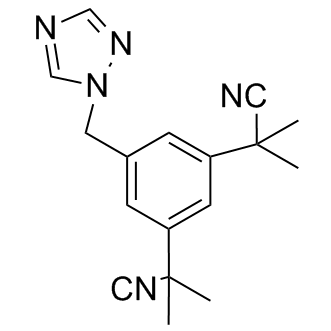| Cas No.: | 120511-73-1 |
| SMILES: | CC(C#N)(C)C1=CC(C(C)(C)C#N)=CC(CN2C=NC=N2)=C1 |
| Formula: | C17H19N5 |
| M.Wt: | 293.37 |
| Sotrage: | 2 years -20°C Powder, 2 weeks 4°C in DMSO, 6 months -80°C in DMSO |
| Description: | Anastrozole is a potent, highly selective aromatase inhibitor, which inhibits human placental aromatase with an IC50 of 15 nM. |
| In Vivo: | Groups of eight immature (22-day-old) female rats are given androstenedione (AD) (30 mg/kg) in arachis oil s.c. daily for3 days with or without various doses of Anastrozole p.o. on day 4 the uteri are dissected, blotted and weighed. An oral dose of 0.1 mg/kg of Anastrozole given on day 2 or day 3 of the cycle completely blocked ovulation. At the same daily dosage (0.1 mg/kg), Anastrozole completely extinguished the uterotrophic activity of exogenous AD in immature rats. In male pigtailed monkeys, twice-daily oral treatment with 0.1 mg/kg and above of Anastrozole reduced circulating oestradiol concentrations by 50-60%[1]. |
| In Vitro: | Anastrozole is a comparatively simple, achiral benzyltriazole derivative, that inhibits human placental aromatase with an IC50 of 15 nM. In the same assay it is 200 times as potent as aminoglutethimide (AG), twice as potent as 4-OHA and one third as potent as Fadrozole[1]. |

 DC Chemicals' products qualify for U.S. tariff exemptions. We guarantee no price increases due to customs duties and maintain stable supply, continuing to deliver reliable research solutions to our American clients.
DC Chemicals' products qualify for U.S. tariff exemptions. We guarantee no price increases due to customs duties and maintain stable supply, continuing to deliver reliable research solutions to our American clients.





















